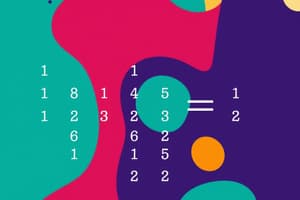Podcast
Questions and Answers
What represents the element in the ith row and jth column of matrix A?
What represents the element in the ith row and jth column of matrix A?
- aij, A
- A(i,j)
- aij (correct)
- Aij
Which type of matrix has only one column?
Which type of matrix has only one column?
- Column Matrix (correct)
- Square Matrix
- Diagonal Matrix
- Row Matrix
What is the defining property of an identity matrix?
What is the defining property of an identity matrix?
- All diagonal elements are zeros.
- 1s on the diagonal and 0s elsewhere. (correct)
- It is a rectangular matrix.
- All elements are equal to one.
When can two matrices be added together?
When can two matrices be added together?
Which operation requires the first matrix's columns to equal the second matrix's rows?
Which operation requires the first matrix's columns to equal the second matrix's rows?
What does the determinant of a matrix indicate?
What does the determinant of a matrix indicate?
What does transposing a matrix involve?
What does transposing a matrix involve?
Which of the following matrices has the property that it is equal to its own transpose?
Which of the following matrices has the property that it is equal to its own transpose?
Flashcards
What is a matrix?
What is a matrix?
A rectangular array of numbers, symbols, or expressions arranged in rows and columns.
Matrix size?
Matrix size?
The size of a matrix is determined by the number of rows (m) and columns (n). It's expressed as m × n. For example, a 3 × 2 matrix has 3 rows and 2 columns.
Row matrix
Row matrix
A matrix with only one row. They are also called row vectors.
Column matrix
Column matrix
Signup and view all the flashcards
Square matrix
Square matrix
Signup and view all the flashcards
Main diagonal
Main diagonal
Signup and view all the flashcards
Identity matrix
Identity matrix
Signup and view all the flashcards
Diagonal matrix
Diagonal matrix
Signup and view all the flashcards
Study Notes
Definition and Notation
- A matrix is a rectangular array of numbers, symbols, or expressions, arranged in rows and columns.
- Matrices are often denoted by uppercase letters (e.g., A, B, C).
- Elements within the matrix are denoted by corresponding lower-case letters with row and column indices (e.g., aij represents the element in the ith row and jth column of matrix A).
- The size or order of a matrix is described by the number of rows (m) and columns (n). It's written as m × n.
Special Types of Matrices
- Row Matrix (or Row Vector): A matrix with only one row (e.g., 1 × n).
- Column Matrix (or Column Vector): A matrix with only one column (e.g., m × 1).
- Square Matrix: A matrix with the same number of rows and columns (e.g., n × n).
- Zero Matrix: A matrix with all elements equal to zero.
- Identity Matrix: A square matrix with 1s on the main diagonal and 0s elsewhere. It's often denoted by I.
- Diagonal Matrix: A square matrix with all off-diagonal elements equal to zero.
- Symmetric Matrix: A square matrix that is equal to its transpose.
- Skew-symmetric Matrix: A square matrix whose transpose is equal to its negative.
Matrix Operations
- Addition: Matrices of the same size can be added by adding corresponding elements.
- Subtraction: Matrices of the same size can be subtracted by subtracting corresponding elements.
- Scalar Multiplication: A matrix can be multiplied by a scalar (a single number) by multiplying each element by the scalar.
- Matrix Multiplication: Matrices can be multiplied if the number of columns in the first matrix is equal to the number of rows in the second matrix. The resulting matrix has the number of rows of the first matrix and the number of columns of the second matrix. The formula for matrix multiplication is (AB)ij = Σk aikbkj.
- Transpose: The transpose of a matrix is obtained by interchanging its rows and columns. Denotation is AT or A'.
- Determinant: A scalar value associated with a square matrix. It's used to determine if a matrix has an inverse. Various methods exist for calculating the determinant, depending on the matrix's dimensions.
- Inverse: Only square matrices can have inverses. The inverse of a matrix A is denoted as A-1 and satisfies the property that AA-1 = A-1A = I, where I is the identity matrix.
- Matrix Equations: Matrices can be used to solve systems of linear equations.
Applications of Matrices
- Systems of linear equations: Matrices provide a concise and efficient way to represent a system of linear equations and solve them via matrix operations.
- Linear transformations: Matrices can represent linear transformations in geometry or other mathematical fields.
- Cryptography: Matrices are used in encryption algorithms.
- Computer graphics: Matrices are used for transformations and manipulations of objects in 2D/3D modeling and animation.
- Engineering: Matrices are ubiquitous in structural analysis, control systems design, and other engineering fields.
- Statistics: Matrices are fundamental to matrix algebra, enabling statistical analysis of data.
Studying That Suits You
Use AI to generate personalized quizzes and flashcards to suit your learning preferences.



